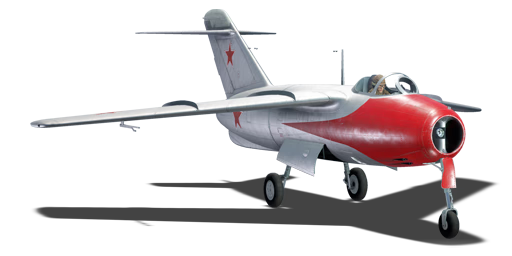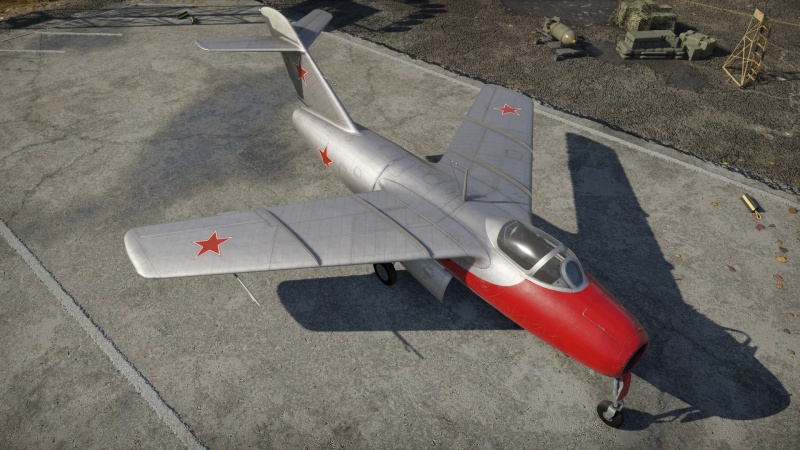La-15
Contents
Description
The La-15 is a rank Soviet jet fighter with a battle rating of (AB), (RB), and (SB). It was introduced in Update 1.39.
The La-15 is a special jet, it lies somewhere in the middle of the 8.0 jets due to its wings being incredibly weak for the engine it possesses and is one of the few planes that can break its wings clean off in level flight. However, due to the battle rating and the speeds that jet combat is usually fought at, you shouldn't need to rely on your top speed: The La-15 can be classed as an underestimated jet, relying on its performance at slow speeds (700 km/h - 300 km/h) to win battles of manoeuvrability.
General info
Flight performance
| Characteristics | Max Speed (km/h at 3,000 m) |
Max altitude (metres) |
Turn time (seconds) |
Rate of climb (metres/second) |
Take-off run (metres) | |||
|---|---|---|---|---|---|---|---|---|
| AB | RB | AB | RB | AB | RB | |||
| Stock | 999 | 969 | 24.0 | 25.2 | 25.6 | 23.8 | 650 | |
| Upgraded | 1,037 | 1,022 | 23.2 | 23.5 | 38.5 | 31.7 | ||
Details
| Features | |||||
|---|---|---|---|---|---|
| Combat flaps | Take-off flaps | Landing flaps | Air brakes | Arrestor gear | Drogue chute |
| ✓ | ✓ | ✓ | ✓ | X | X |
| Limits | ||||||
|---|---|---|---|---|---|---|
| Wings (km/h) | Gear (km/h) | Flaps (km/h) | Max Static G | |||
| Combat | Take-off | Landing | + | - | ||
| 500 | 470 | 320 | ~12 | ~6 | ||
| Optimal velocities (km/h) | |||
|---|---|---|---|
| Ailerons | Rudder | Elevators | Radiator |
| < 640 | < 535 | < 630 | N/A |
Engine performance
| Engine | Aircraft mass | ||||||
|---|---|---|---|---|---|---|---|
| Engine name | Number | Empty mass | Wing loading (full fuel) | ||||
| Klimov RD-500 | 1 | 2,790 kg | 228 kg/m2 | ||||
| Engine characteristics | Mass with fuel (no weapons load) | Max Takeoff Weight | |||||
| Weight (each) | Type | 11m fuel | 20m fuel | 30m fuel | 39m fuel | ||
| 567 kg | Centrifugal-flow turbojet | 3,054 kg | 3,262 kg | 3,492 kg | 3,700 kg | 3,870 kg | |
| Maximum engine thrust @ 0 m (RB / SB) | Thrust to weight ratio @ 0 m (112%) | ||||||
| Condition | 100% | 112% | 11m fuel | 20m fuel | 30m fuel | 39m fuel | MTOW |
| Stationary | 1,350 kgf | 1,499 kgf | 0.49 | 0.46 | 0.43 | 0.41 | 0.39 |
| Optimal | 1,350 kgf (0 km/h) |
1,499 kgf (0 km/h) |
0.49 | 0.46 | 0.43 | 0.41 | 0.39 |
Survivability and armour
- 105 mm Bulletproof glass in cockpit front
- 8.5 mm Steel plate behind the pilot
- 6 mm Steel plate in the nose
Modifications and economy
Armaments
Offensive armament
The La-15 is armed with:
- 3 x 23 mm NR-23 cannons, chin-mounted (100 rpg = 300 total)
Usage in battles
The La-15 should be used in as an American Fighter when not in engagements (straight lines, absolute minimal turning to retain speed) and as a "jet-turn-fighter" when in engaged with enemy aircraft.
Here are the DON'Ts of the La-15...
- DON'T climb at the beginning of the match, use the beginning of the match to fly straight forward to the enemy, as low to the ground you can get.
- DON'T keep yourself on 100% throttle. Use the special 112% power that the La-15's engine gives you. The WEP, as one could call it, lasts for a long time, and when overheating, just simply turn it off for about 15 - 60 seconds, after which it can be turned on again
- DON'T commit to a head-on attack or turn hard after one. Your guns are hard to aim in the heat of head-on and it would be advised to break when closing in on a head-on, or preemptively turn to get on their 6 immediately.
- DON'T get into a situation where you must fly at high speeds defensively. When an enemy shows up on your tail, if you have superior speed, outrun him, however, if he has superior speed, slow down to a point in which higher G turns don't G-lock you and where you can take full advantage of an enemy fighter's higher speed to get behind them. Make them bleed their energy turning to get you while avoiding their attacks and engage your flaps when you're slow enough to deploy without ripping.
However, DO the following:
- DO go straight at the beginning of the match, the La-15 still can reach a high enough speed where it can outrun planes that turn to get behind you.
- DO bring 11 - 20 minutes of fuel at maximum. You'll have enough fuel to last you a usual jet battle's time with WEP on when you need it, and you won't catch on fire. The La-15 has a lot more manoeuvrability when only 11 minutes of fuel are taken. Do keep in mind that only taking 11 minutes of fuel will result in a lower wing rip speed of around 920 - 910 kph!
- DO keep going straight after you break from a head-on attack or overshoot, you can win the acceleration battle with almost any American jet you face. You are light, as with almost all Russian jets you are much lighter than your American counterparts and will always win a battle of low speed acceleration, but lose a battle of diving acceleration.
- DO slow down when an enemy plane that's faster than you are behind you. Most enemy planes will try to keep their speed, which puts you in a situation to pull hard turns without G-locking. If you're fast, do some light horizontal turns, but don't turn into the vertical, most American fighters will beat you at energy retention at higher speeds then have no acceleration when they stall which leads you to always be in front of their guns. If possible, keep rolling and spiraling, using your 'w' 'a' 's' 'd' keys to dodge attacks and then come out as the slower but still manoeuvrable plane when they try to dogfight you.
Specific enemies worth noting
F-86 Sabre/CL-13A Sabre:
The F-86 Sabre is one of the main rivals of the La-15 if up-tiered and facing allied teams. The Sabre can easily outmanoeuvre, outrun, and out climb the La-15. The best way to counter the Sabre is to attack it when it is at its most vulnerable position (low on energy, or damaged) or force it into a low-speed manoeuvring fight. Do not try to engage an F-86/CL-13A Sabre in any high-speed manoeuvres or any high-speed dogfighting in general as the Sabre will come out on top. In any low-speed manoeuvres, the Sabre will lose to the La-15 in any manoeuvring engagements.
Meteor:
The Meteor is another main rival of the La-15 as the La-15 can meet the Meteor at any time from being down-tiered to up-tiered. While the La-15 can outrun and out climb early variants of the Meteors, the later variants are far harder to outrun and outclimb as they can easily catch the La-15. The best way to deal with Meteors is to apply boom and zoom tactics, but do remember a skilled Meteor pilot will have no issue avoiding a La-15 that is attacking with boom and zoom tactics. Avoid any manoeuvring fights with any variant of the Meteor as they will outmanoeuvre you with no issues at all.
Counter-tactics
The La-15 has, at best, a speed limit of 1000 km/h. Be aware of this and, if possible, try to out dive or outrun the La-15, as it can break its wings easily in a dive and in level flight. Its airbrake is ineffective in a hard dive unless the engine is turned off, so turn on an afterburner and keep it on until you have gotten into level flight. If you are slower than the La-15, Do not try to climb, break, or use an airbrake, the La-15 has very good energy retention in a climb and it's airbrake very effective at level flight, so refrain from these types of defensive flying.
Pros and cons
Pros:
- Cannons have a decent rate of fire and punch.
- Good energy retention.
- Decent acceleration.
- Cockpit visibility is above average.
- Decent manoeuvrability around 500-700 km/h (310-435 mph).
- Good roll rate.
Cons:
- Low top speed.
- Can rip its wings off in level flight (speed warning at approximately 945 kph/587 mph, wings rip at 955 kph/593 mph).
- Ineffective airbrake.
- Guns have poor accuracy and very low muzzle velocity. Hitting a target can be difficult.
- Ammunition is limited, restricted to firing short accurate bursts from close range.
- Doesn't take battle damage very well especially to the wings of the aircraft.
History
The La-15 was a contemporary of the MiG-15 and Yak-30, that would see limited production numbers and remain in service through the 1950s in secondary roles. The NATO name for it was "Fantail."
Designer S.A. Lavochkin followed on his successful line of World War II piston-engine fighters with a series of jet prototypes in 1947. One of these, the La-174, became the basis for the production La-15. The fighter used a licence-built Rolls-Royce Derwent engine. A larger and more capable prototype, the La-176D, would be the first Soviet aircraft to break Mach (first in a dive in 1948 and then in level flight the next year) but never entered production.
Media
- Skins
- Videos
See also
- Related development
- Aircraft of comparable role, configuration and era
External links
| Lavochkin Design Bureau (Лавочкинa Опытное конструкторское бюро) | |
|---|---|
| LaGG-3* | I-301 · LaGG-3-4 · LaGG-3-8 · LaGG-3-11 · LaGG-3-23 · LaGG-3-34 · LaGG-3-35 · LaGG-3-66 |
| La-5/7 | La-5 · La-5F · La-5FN · La-7 · Dolgushin's La-7 · La-7B-20 |
| La-9/11 | La-9 · La-11 |
| Jet Fighters | La-15 · La-174 · La-200 |
| Export | ␗La-9 · ␗La-11 |
| Captured | ▀La-5FN |
| *Lavochkin-Gorbunov-Gudkov (Лавочкин-Горбунов-Гудков), head designer V. P. Gorbunov | |
| USSR jet aircraft | |
|---|---|
| Bereznyak-Isayev | BI |
| Yakovlev | Yak-15 · Yak-15P · Yak-17 · Yak-23 · Yak-28B · Yak-30D · Yak-38 · Yak-38M · Yak-141 |
| Mikoyan-Gurevich | MiG-9 · MiG-9 (l) · MiG-15 · MiG-15bis · MiG-15bis ISh · MiG-17 · MiG-17AS · MiG-19PT |
| MiG-21F-13 · MiG-21PFM · MiG-21S (R-13-300) · MiG-21SMT · MiG-21bis | |
| MiG-23M · MiG-23ML · MiG-23MLD · MiG-27M · MiG-27K | |
| MiG-29 · MiG-29SMT | |
| Lavochkin | La-174 · La-15 · La-200 |
| Sukhoi | Su-9 · Su-11 |
| Su-7B · Su-7BKL · Su-7BMK · Su-17M2 · Su-17M4 · Su-22M3 | |
| Su-24M | |
| Su-25 · Su-25BM · Su-25K · Su-25T · Su-25SM3 · Su-39 | |
| Su-27 · Su-27SM | |
| Su-34 | |
| Ilyushin | IL-28 · IL-28Sh |
| Tupolev | Tu-14T |





